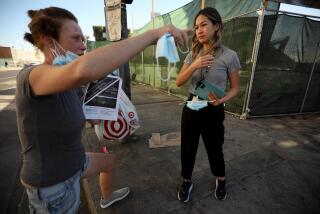Among Women, AIDS Is Diagnosed Late, Doctor Says
- Share via
IRVINE — Women’s reluctance to take charge of their own health needs leads to the late diagnosis of the virus that causes AIDS and contributes dramatically to rising mortality rates among women who contract the disease, a leading physician in HIV care said Saturday.
Centers for Disease Control statistics show that 11% of women found to have the virus last year in the United States died within the same month that their illness was diagnosed, Dr. Patricia Wetzell said. Wetzell, of John Peter Smith Hospital in Ft. Worth, was speaking at the “Women and HIV” seminar at UC Irvine.
“This does not have to happen,” she said. “So many cases in women are being identified very late in the process. They don’t perceive the risk and they have not been accessing the health care system.”
Wetzell herself was found to have the virus last year after suffering a needle stick while drawing blood from an AIDS patient. She said many women fear discrimination or simply fail to confront potential health problems because of long-accepted social norms.
“In our society, women have traditionally taken the role of care-givers and are sometimes uncomfortable about having to be taken care of,” the physician said. “The whole issue revolves around getting women access to health care. Women have to be empowered to take charge of their lives.”
In other cases, Wetzell said, health care professionals have been slow to provide testing, especially when their patients are heterosexual women. Because transmission of the human immunodeficiency virus--which causes AIDS--has been more commonly found among gay men and intravenous drug users, some physicians and nurses are not considering the disease’s increasing presence among heterosexuals, particularly women.
In 1991, for example, the nationwide rate of reported AIDS cases among homosexual men increased by 19%, compared to 37% among women--the largest increase of any population group, according to the Centers for Disease Control. Among women between ages of 25 and 44, AIDS is the fifth leading cause of death in the nation. In New York City, it ranks first.
Wetzell’s brief recitation of CDC statistics, specifically those involving death rates, brought gasps from the audience, which included both health care professionals and women who have been found to have the virus.
“We can’t wait until this (high incidence rate) makes its way across the country,” Wetzell said. “We have to do something now. This is a changing epidemic. What is so distressing to me is to hear of women going to their health care providers and the topic of HIV or AIDS never being discussed.”
Since the early 1980s, the Orange County Health Care Agency has documented 2,221 AIDS cases. Of those cases, 115 have been women, 71 of whom have died.
The incidence of HIV transmission through drug needles is not as high in Orange County as it is in larger urban areas. However, county officials are concerned that many cases are not being reported because of traditional social stigmas and fear of discrimination.
Because of those factors, Pearl Jemison-Smith, chairwoman of the county’s HIV Planning Advisory Council, said she and other county advocates are planning to offer a countywide anti-discrimination ordinance by next year designed to protect those living with HIV.
“It doesn’t matter that you are white or rich, if you have the disease, you can still be discriminated against. Just look at Magic Johnson,” she said, referring to the HIV-infected Los Angeles Lakers basketball star. Johnson’s recent retirement was prompted by fears of transmission expressed by other National Basketball Assn. players.
Among those attending the conference was Tamara Lindley Brown, 32, of Costa Mesa, who was found to have HIV last March. Brown said she generally agreed that women at risk have been reluctant to seek help.
“A lot of women are in seclusion,” she said. “They don’t want to be a burden. Here, I’ve finally been able to see other women with HIV. It gives me a feeling of hope. I feel like I’m not alone.”
More to Read
Sign up for Essential California
The most important California stories and recommendations in your inbox every morning.
You may occasionally receive promotional content from the Los Angeles Times.













